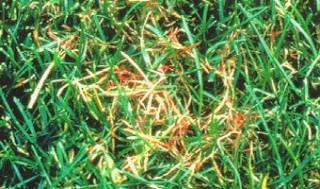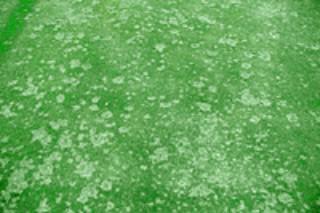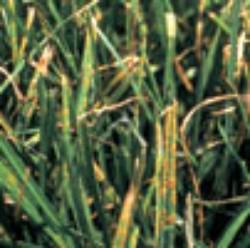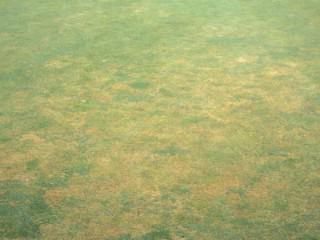Diseases
Plant diseases that occur in many lawns are disorders which are caused by microorganisms such as fungi and bacteria which, when given the correct environment, will attack the turf. Almost all turf grass diseases are caused by fungi. Fungi cannot produce their own chlorophyll and so use that which is produced by the turf grass. Depending on the type of disease present and the stage of life cycle it is in will determine the extent of damage that has or will occur and the treatment necessary to eradicate it. Some of these are easily curable and tend not to return but others are more troublesome and can take more effort to get rid of.
Common Lawn Diseases
- Fusarium ( Microdochium Nivale )
Fusarium Patch disease is the most common of all lawn diseases in the UK. It is recognised by the die-back of quite large areas of grass on compacted lawns in particular. Usually found in Autumn, but also in Spring after there has been snow lying on the lawn for some lengthy period. It can spread and take hold under cover of snow - hence it's common name of Snow Mould.
Fusarium Patch disease starts as a small yellowing patch which turn brown as the patches enlarge. Sometimes - in damp weather - a white or pinkish mould can be seen in the patches. It normally subsides a little as the air temperature warms up and lawns dry out a little. As with all diseases, it is much easier to prevent than to cure.

- Fairy Rings (Agaricus Campestris)
These can occur in any turf or grass lawn and present themselves as a circular discoloration of grass varying in size from several inches up to several feet in diameter.
Toadstools may appear around the edge of the rings during humid or wet weather - hence the name - and if left untreated for a period of time may kill the infected patch of turf or grass.
In some instances the particular patch of turf or grass may become so infected that the only way to cure the problem is to cut away the patch of damaged grass and replace it with a new one.

- Red Thread (Laetisaria Fuciformis)
From the Latin Laestisaria Fuciformis, Red Thread is a fungal disease that attacks grass and has the appearance of irregular patches of reddish hued grass. With a closer inspection you should see that the infected leaves have a small reddish spike protruding on their tips.
The roots of the infected leaves are not normally affected by this disease so recovering is a fairly simple procedure but the infection normally rears its head in later summer months where there are periods of high humidity and where soil is compacted due to general wear and tear rendering it short of nitrogen.

Regular feeding with a lawn feed that will provide significant levels of nitrogen should cure this problem.
- Dollar Spot (Sclerotinia Homoeocarpa)
Dollar spot manifests itself as silvery-grey spots appearing on your lawn in sizes varying from one to six inches in diameter. Sometimes these spots can intermingle causing larger areas of grass to appear damaged.
Dollar spot is generally caused by a lack of moisture in the soil and/ or a lack of nitrogen.

Again, regular feeding of the lawn should help prevent any further occurrences of this problem.
- Common Toadstool (Panaeolus Foenisecii)
These are common garden fungi that begin as air borne spores and which can settle anywhere in the garden.
On the lawn, however, they thrive, especially if there is a high level of thatch left under the grass and between the base of the grass and the soil.
Thatch provides humidity and heat for these spores to grow and manifest themselves as Toadstools and Puffballs.

Regular raking will ensure that the amount of thatch - or dead grass - is kept to a minimum.
- Rust (Puccinia)
As the name might suggest this is a fungal disease that manifests itself by changing the grass colour from green to yellow and then as late summer approaches, as yellow or brown spots on the leaves of grass.
Rust thrives in warm damp conditions and heavy dew can lead to the problem occurring. It is most common in lawns where nitrogen is in short supply so regular feeding with a feed that is designed for nitrogen-deficient lawns should cure the problem.

These are the most common forms of lawn disease and can affect both grass and turf lawns alike.
- Anthracnose (Colletotrichum Cereale)
Anthracnose diseases are common and destructive problems in lawns Anthracnose may develop as a foliar blight, in which the turf-grass leaves are infected, or a basal rot, which attacks the leaf sheaths, crowns, and stolons of the plant.
Anthracnose symptoms are highly variable, appearing yellow to orange in colour and in an irregular pattern, in small freckle-like spots, or in circular patches up to 1’ in diameter. Symptoms are typically most severe in areas that are stressed from low mowing, excessive traffic, or inadequate irrigation or fertilization.
On individual plants, symptoms first appear on the oldest leaves, which die back from the tip, and gradually progress to the younger leaves.

